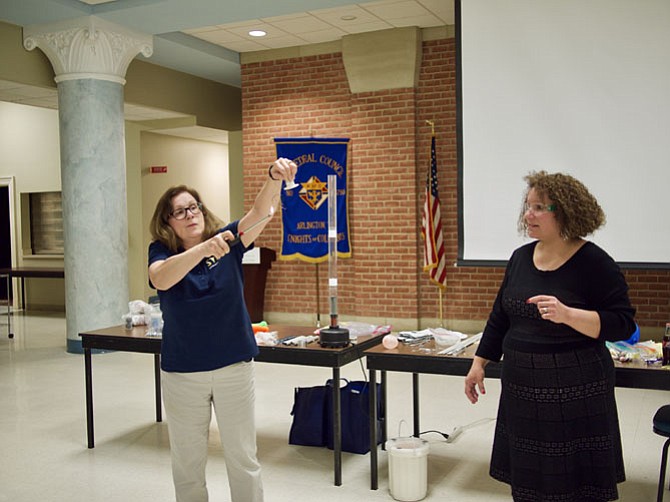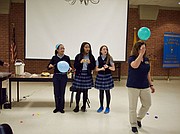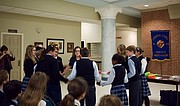Dr. Angela Moran asks teacher Raylene Rozzi, “You aren’t afraid of fire, are you?” as she straightens out Nitinol with an electric match. Photo by Eden Brown.
“I’ve been an engineer for 37 years and I have never had a day I wasn’t excited to come to work.” — Dr. Angela Moran, U.S. Naval Academy engineer
“I like to build stuff but I really like to figure out why things break,” said Dr. Angela Leimkuhler Moran with a twinkle in her eyes. She had already caught the attention of a room full of Arlington’s St. Thomas More School middle schoolers. She asked how many students in the room of about 90 had a connection to the U.S. military or naval academy, and more than 20 raised their hands. “Well,” she said, “I’m an engineer. And our main job is to make the world a better place, and, for the military, to make sure our materials are really strong.”
She used the example of a cell phone. “It used to be the size of a brick, and all it did was make phone calls, and not very well. But now,” she said, “we have smart phones that fit in your hand, that do everything from take photos to playing YouTube videos. Engineers made that happen.”
Moran, a Naval Academy materials engineer, asked the students if they knew what silicon was. She pointed out the use of silicon, an element on the periodic table, and how electronic pathways could be etched on it. “Materials is a really cool area of engineering,” she said. She asked the students if they knew how many materials there were. It turned out there were 100,000 different materials to select from if one were an engineer, and they all fell neatly into three categories: metals, polymers, ceramics. Moran is the kind of engineer that makes even categories of materials sound interesting, and she bounced around the room showing students materials, and, best of all, letting them feel them, hear them, stretch them, and stomp on them. As she described the properties of materials (strong and conductive, brittle but tough), she had an attentive audience.
But when she called for volunteers from the audience to come up and help her with some experiments, the most skeptical of middle schoolers was entranced by a world of science that was much more interesting than memorizing the table of elements.
And when Moran thought she was losing anyone’s attention, she knew what to do. “You know what?” she asked the room, “What we should do is get a teacher up here!” The room erupted in approval. She proceeded to demonstrate the properties of materials (who knew metal is elastic), and highlighted the shape-memory-alloy Nickel Titanium (Nitinol) which has a superelastic effect. Nitinol is used in braces for teeth, eyeglasses, stents, and a multitude of other things used everyday.
Moran is one of several scientists who will be visiting Arlington schools as guest lecturers, providing insights about their careers and work as part USA Science & Engineering Festival’s Nifty Fifty Program which sends more than 200 top scientists and engineers into schools around the country in advance of the festival to ignite students’ passion for science and engineering. Taking place April 7-8 in Washington, D.C., the festival’s Expo, sponsored by founding and presenting host Lockheed Martin, is a free event that allows youths and adults to participate in more than 3,000 hands-on activities and see live performances by science celebrities and experts.
Moran had a little something extra for the teachers who attended the event: She told teachers they can come to the U.S. Naval Academy for an 8-hour workshop on Saturdays in the Fall and Spring, where they can learn things like sensor technology and experimental design. It’s free, participants get a free meal, and it counts towards recertification credits. Moran offered her email address (amoran@usna.edu) or the USNA STEM Educator Training email address, usnastem@usna.edu, as a reference for this program. The program is open to all.
Moran closed with a pitch to study math and science and follow in her footsteps. “I’ve actually been an engineer for 37 years,” she said, “And
I’ve never had a day when I wasn’t excited to come to work.”


